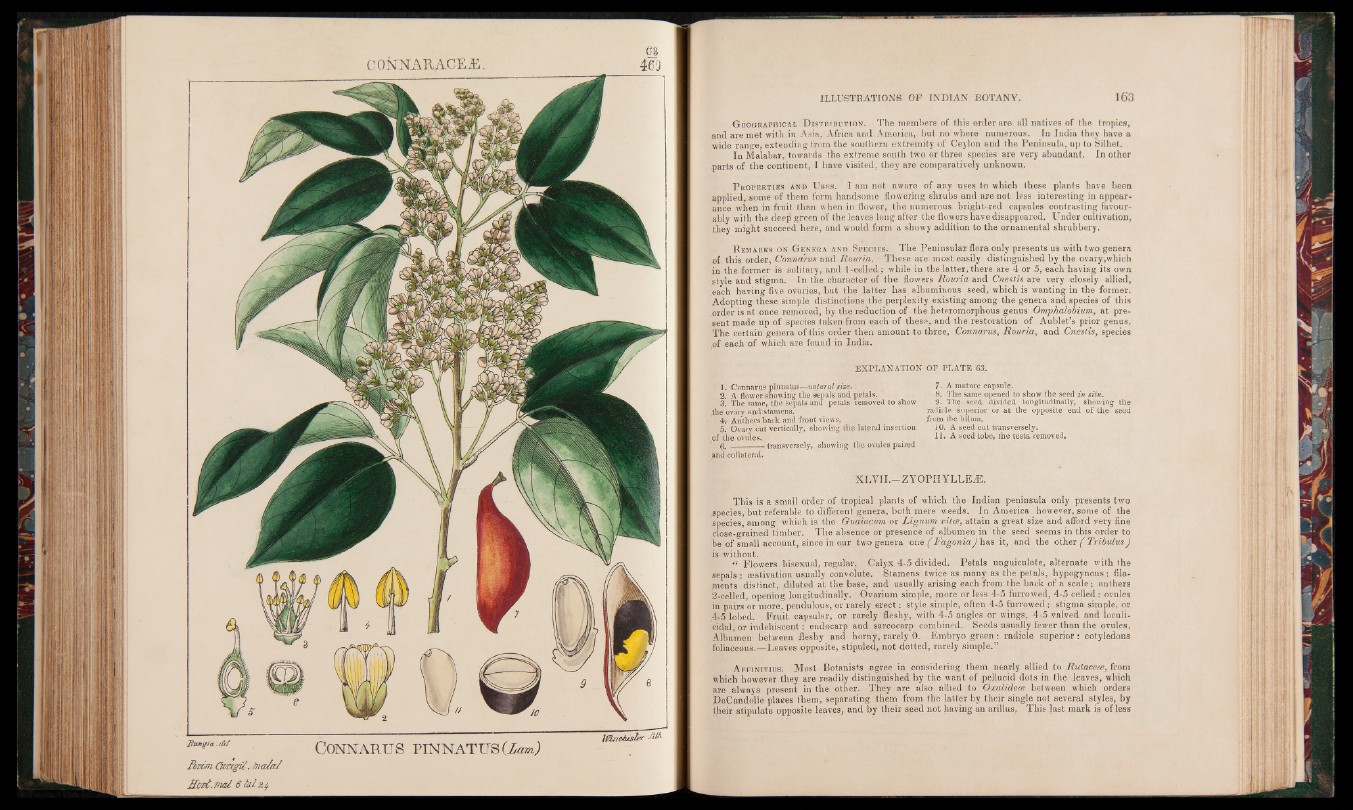
CONNARUS PINNATUS (Lam.)
G eographical D istribution. The members of this order are all natives of the tropics,
and are met with in Asia, Africa and America, but no where numerous. In India they have a
wide range, extending from the southern extremity of Ceylon and the Peninsula, up to Silhet.
In Malabar, towards the extreme south two or three species are very abundant. In other
parts of the continent, I have visited, they are comparatively unknown.
P roperties and U ses. I am not aware of any uses to which these plants have been
applied, some of them form handsome flowering shrubs and are not less interesting in appearance
when in fruit than when in flower, the numerous bright-red capsules contrasting favourably
with the deep green of the leaves long after the flowers have disappeared. Under cultivation,
they might succeed here, and would form a showy addition to the ornamental shrubbery.
R emarks on G enera and Species. The Peninsular flora only presents us with two genera
of this order, Connarus and Rouria. These are most, easily distinguished by the ovary,which
in the former is solitary, and 1-celled; while in the latter, there are 4 or 5, each having its own
Style and stigma. In the character of the flowers Rouria and Cne-stis are very closely allied,
each having five ovaries, but the latter has albuminous seed, which is wanting in the former.
Adopting these simple distinctions the perplexity existing among the genera and species of this
order is at once removed, by the reduction of the heteromorphous genus Omphalobium, at present
made up of species taken from each of these, and the restoration of Aublet’s prior genus.
The certain genera of this order then amount to three, Connarus, Rouria, and Cnestis, species
pf each pf which are found in India.
EXPLANATION .OF PLATE 63,
1. Connarus pinnatus—natural rsize.
2. A flower showing the sepals and petals.
3. The same, the sepals and petals removed to show
.the ovary andistamens.
4* Anthers back arid front Views.
5. Ovary cut vertically, showing the lateral insertion
of the ovules,
. 6. — — :— - transversely, showing th.e ovules paired
and collateral.
7- A mature capsule.
8. The same opened to show the seed in situ.
9. The seed divided longitudinally, showing the
radicle superior or at the opposite end of th.e seed
from the hilum.
10. A seed cut transversely.
11. A seed lobe, the testa removed.
XLVII.—ZYOPHYLLEÆ,
This is a small order of tropical plants of which the Indian peninsula only presents two
.species, but referable to different genera, both mere weeds. In America however, some of the
species, among which is the Guaiacum or Lignum vitce, attain a great size and afford very fine
close-grained timber. The absence or presence of albumen in the seed seems in this order to
be of small account, since in our two genera one ( FagoniaJ has it, and the other ( Tribulus)
is without. • ,
“ Flowers bisexual, regular. Calyx 4-5 divided. Petals unguiculate, alternate with the
sepals : æstivation usually convolute. Stamens twice as many as the petals, hypogynous : filaments
distinct, dilated at the base, and usually arising each from the back of a scale : anthers
2-celled, opening longitudinally. Ovarium simple, more or less 4-5 furrowed, 4-5 celled : ovules
in pairs or more, pendulous, or rarely erect : style simple, often 4-5 furrowed : stigma simple, or
4,5 lobed. Fruit capsular, or rarely fleshy, with 4-5 angles or wings, 4-5 valved and loculi-
cidal, or indéhiscent : endocarp and sarcocarp combined. Seeds usually fewer than the ovules.
Albumen between fleshy and horny, rarely 0. Embryo green : radjcle superior cotyledons
foliaceousÿf-Leaves opposite, stipuled, not dotted, rarely simple.”
A ffinities. Most Botanists agree in considering them nearly allied to Rutaceoe, from
which however they are readily distinguished by the want of pellucid dots in the leaves, which
are always present in the other. They are also allied to Oxalidece between which orders
PeCandolle plaees them, separating them from the latter by their single not several styles, by
.their stipulate opposite leaves, and by their seed not having an arillus, This last mark is of less